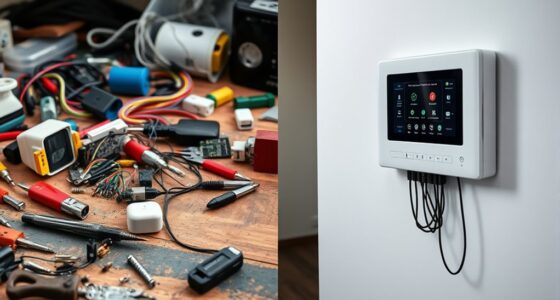To replace the battery in your home security system, the first step is to inform your monitoring center to prevent any false alarms. Put your system into test mode and turn it off for safety precautions. Determine which devices require new batteries, like the control panel or sensors. Use the appropriate tools to access the battery compartment, then remove the old battery and insert the new one, making sure the connections are secure. Once you have installed the new battery, test your system to ensure it is functioning correctly. If you need more guidance and detailed instructions, you can find additional information on the process.
Key Takeaways
- Notify the monitoring center and set the security system to test mode before starting the battery replacement process.
- Identify the correct battery types for each device, such as 12v for the control panel and AA for sensors.
- Carefully remove the old battery by disconnecting the negative terminal first, then the positive, and then install the new battery.
- Ensure that all battery connections are tight and check for any error messages on the keypad after installation.
Identify Devices Needing New Batteries
To keep your home security system running smoothly, you need to identify which devices require new batteries. Start with the control panel; it typically relies on a large single 12v battery for operation. If your alarm system isn't responding, this could be the culprit.
Next, check the keypads. They may contain a special battery pack that also needs replacement. Regular maintenance of your security devices is vital, as it guarantees reliability and effectiveness, much like what to look for in a home cleaning service.
Don't forget the door and window sensors. These devices usually run on standard AA batteries, so make it a habit to check them regularly. Motion detectors are another essential part of your home security systems and often use common household batteries, which can vary by manufacturer. Be sure to inspect these as well.
Lastly, examine the glassbreak detectors, as they might require flat coin-shaped batteries. Verify you inspect each device to confirm that they're functioning correctly.
Keeping track of these batteries is essential for maintaining the effectiveness of your security setup. Remember, a small investment in replacing batteries can save you from larger issues down the line. Regular checks can help guarantee your home remains secure and protected.
Notify Monitoring Center

It's essential to notify your monitoring center before changing the battery in your home security system to prevent triggering a tamper alarm.
When you contact your monitoring company, you make certain they're aware of the maintenance you're performing, which helps avoid unnecessary police dispatch due to false alarms during the battery replacement process.
Additionally, being familiar with return policies for electronics can be beneficial in case you need to replace any malfunctioning components of your security system.
Security systems use various alerts to communicate status changes, and even after notifying the monitoring center, you might still hear beeping sounds or see tamper errors. This is normal during battery changes, so don't panic.
However, keeping your monitoring center informed is a significant step in maintaining the integrity and functionality of your system.
If you have a professionally monitored security system, prior notification is especially important.
It allows the monitoring company to recognize that any alerts are part of routine maintenance and not a security breach.
This proactive communication not only safeguards your home but also helps maintain a good relationship with your monitoring provider.
Access Current Battery

After notifying your monitoring center, locate the battery compartment of your home security device to begin the replacement process.
Depending on the type of your home security system, the battery compartment can usually be found in the control panel, keypad, or individual sensors. For traditional systems, batteries are often housed in metal boxes, while newer models might conceal them within the keypad casing.
It's crucial to verify your system meets high-quality standards, as this can enhance user satisfaction through reliable functionality and reduce the risk of defects and failures in production.
To access the battery, you'll need to identify the correct compartment. Look for recognizable battery types or sizes, such as a large single 12v battery for the control panel, or AA batteries for door and window sensors.
If you're unsure about the battery type, don't hesitate to consult the user manual or contact your home security company for clarification. You can also refer to best practices in software quality assurance for systematic approaches that guarantee thorough testing processes.
Before you start, make sure you have the appropriate tools handy, like a screwdriver or a control panel key, to safely access the battery compartment.
Taking these steps will help you smoothly access the battery and prepare for the replacement process, guaranteeing your home security system remains operational and effective.
Replace Current Battery

Now that you've accessed the current battery, it's time to replace it.
Before proceeding, verify you have the correct replacement battery type for your specific security system, as using the wrong battery can lead to performance issues.
Start by carefully removing the old battery, paying attention to how the wires are connected.
Next, you'll install the new battery and make certain all connections are secure for peak performance.
For additional home safety tips, consider essential kitchen gadgets that can enhance your overall home security.
Proper Removal Techniques
To safely remove the old battery from your home security system, start by disconnecting the black wire from the negative terminal before the red wire from the positive terminal. This order prevents any potential short circuit and keeps your alarm system safe during the process.
Additionally, confirming that your home security system is operating efficiently can be aided by having reliable components, such as the top-rated garage door openers for enhanced security features.
If the connectors are stubborn, don't hesitate to use appropriate tools like a screwdriver or pliers to loosen them. Once both wires are disconnected, carefully lift the old battery out of its compartment. It's a good idea to keep this old battery until you have the new one on hand. This way, you can easily compare sizes and voltage specifications to guarantee a perfect match.
Before you dispose of the old battery, make sure to follow local regulations for battery recycling. This helps minimize environmental impact and keeps your community safe.
Installing New Battery
Carefully position the new battery in the compartment, ensuring you align the terminals just like the old one for a seamless installation.
It's essential to match the new battery's specifications to the old one, focusing on size and voltage, which is typically 12 volts for control panels. Additionally, consider checking the battery's compatibility with your specific security system model to avoid any issues during installation. When replacing batteries, it's also wise to follow smart organization techniques to keep your home systems running efficiently.
Once the battery is in place, connect the new battery by attaching the red lead to the positive battery terminal and the black lead to the negative terminal securely. This connection is critical for your system to function efficiently.
After connecting the leads, close the battery compartment securely to protect the new battery from external elements. You don't want any moisture or dust to interfere with your alarm system's performance.
Ensuring Secure Connections
Guaranteeing secure connections during battery replacement is essential for your home security system to function properly. When you install the new battery, make sure it matches the specifications of the old one, typically a 12-volt for control panels.
Proper guidance in handling equipment can enhance your overall personal growth and wellness as you learn to maintain your home systems. Carefully connect the red lead to the positive terminal and the black lead to the negative terminal of the new battery. A secure fit is critical to avoid connection issues that could compromise your system.
After you've connected the battery, verify that the connections are tight and stable. Gently tug on the leads to confirm they won't disconnect during operation. If your system uses a battery pack or specialized batteries, consult the user manual for the correct installation procedure. This step is essential for guaranteeing the battery functions as intended.
Once the battery is in place, check for any error messages on the keypad. Reset the system as needed to confirm that all connections are secure and functioning correctly. A little diligence now can save you from future headaches, keeping your home security system reliable and effective.
System Testing and Maintenance
How often do you test your home security system to verify everything's functioning properly after a battery change?
After replacing the battery, it's important to conduct system testing to make sure all components are working correctly.
Verify that the new battery is providing adequate power and address any low battery warnings that might arise.
Contact your monitoring center for assistance in checking the functionality of your sensors and alarms, as they'll help confirm everything's operational.
Don't forget to clear any keypad errors that may appear post-battery replacement. This step is vital for maintaining the proper status of your system.
It's advisable to test your alarm system monthly, confirming ongoing performance and reliability.
Regular maintenance not only helps detect any potential issues early but also prevents false alarms that could cause unnecessary stress.
Warranty Considerations

When dealing with your home security system's battery, it's crucial to understand the warranty considerations to avoid any unexpected issues. Here are four key points to keep in mind:
- Battery Exclusions: Most warranties exclude battery replacements, meaning you're responsible for maintenance.
- Regular Checks: Failing to replace your batteries on time could void your service agreements with your security provider.
- Documentation: Keep a record of battery replacement dates and any communication with your provider for warranty claims.
- Review Terms: Always check your warranty terms before attempting any DIY maintenance to confirm compliance.
Being proactive about these warranty considerations can save you headaches down the line. If you're unsure about your warranty coverage, don't hesitate to reach out to your security system provider for clarification. They may even offer guidance on battery replacement over the phone, but know that in-person service may come with additional costs.
Understanding these details can help you maintain your security systems effectively while keeping your warranty intact. Regular maintenance not only affirms your system operates efficiently but also protects your investment.
Preparing for Battery Replacement

Preparing for battery replacement involves taking a few essential steps to confirm the process goes smoothly and safely. Start by contacting your alarm monitoring company to notify them about the maintenance, which helps prevent false alarms. Next, set your security system to test mode to avoid alerts during the battery swap.
Here's a helpful checklist to guide you through the preparation:
| Step | Action | Importance |
|---|---|---|
| Contact Monitoring Company | Inform them of maintenance to prevent false alarms | Avoid unnecessary police dispatch |
| Set to Test Mode | Change setting to test mode | Prevent alerts during replacement |
| Power Down the System | Disconnect transformer or flip circuit breaker | Confirm safety while handling battery |
| Gather Tools | Have screwdriver or control panel key ready | Access battery compartment efficiently |
Proper Battery Replacement Procedure

When replacing the battery, make certain you use the correct battery type specified for your security system.
It's essential to verify the connection orientation, guaranteeing the red wire connects to the positive terminal and the black wire to the negative terminal.
This simple check can prevent potential damage and guarantee your system runs smoothly.
Battery Type Specification
Choosing the right battery for your home security system is essential for guaranteeing its reliable operation. A compatible battery not only keeps your system functioning but also enhances its performance and lifespan. When you head to the battery store, keep these key points in mind:
- Voltage: Confirm the new battery matches the old one, typically a 12-volt type for control panels.
- Size: Check the size specification indicated by Amp-Hours (AH) or Milliamp-Hours (mAH).
- Compatibility: Use a battery of the same size and voltage to maintain peak performance.
- Charge Check: Test the new battery with a multimeter before installation to confirm it's functioning correctly.
Once you've acquired the right new battery, remember to connect it properly.
Always attach the red lead to the positive terminal and the black lead to the negative terminal. Securely tighten the connections on the battery terminals to prevent any loose connections that could lead to malfunctions.
Connection Orientation Verification
Verify the connection orientation by confirming the red wire connects to the positive terminal and the black wire to the negative terminal. This connection orientation verification is vital to prevent short circuits and guarantee your home security system operates correctly.
Before installing the new battery, check the orientation matches that of the old battery. Most home security systems use a 12-volt battery, so confirm the new battery's specifications for compatibility.
When you're ready to connect the new battery, pay close attention to the red wires and their placement.
Tighten the connections securely after you've attached the wires. Loose terminals can lead to intermittent power loss or system malfunctions, compromising your security setup.
Once the battery is installed, monitor the keypad for any error messages. If you see any alerts, it could indicate improper connections or battery issues.
Taking the time to verify the connection orientation guarantees your system functions smoothly, providing you peace of mind. Proper battery replacement is essential, so don't skip these steps to maintain your home's security.
Additional Resources and Insights

Staying updated on home security trends can greatly enhance your system's effectiveness and longevity. To help you stay informed, here are some additional resources to take into account:
- Maintenance Blogs – Regularly visit blogs that cover battery replacement procedures and maintenance tips for your alarm systems.
- CCTV Integration Articles – Explore articles that detail how integrating CCTV can bolster your home security.
- Practical Advice Posts – Utilize popular posts that offer insights into alarm systems and access control measures to improve your security strategy.
- Customer Support Resources – Take advantage of downloadable user manuals and troubleshooting guides for easy reference during maintenance.
For any service requests or inquiries about battery replacement or system upgrades, don't hesitate to contact your security provider directly. They can offer prompt assistance tailored to your specific needs.
Frequently Asked Questions
Can I Change a House Alarm Battery Myself?
Yes, you can change a house alarm battery yourself! Most systems allow easy access for replacement. Just make sure you've got the right battery, notify your monitoring company, and follow the manufacturer's instructions for a smooth process.
How Do I Change the Battery on a Security System?
To change the battery on your security system, start by contacting your monitoring company. Next, locate the battery compartment, disconnect the old battery, connect the new one, and test the system to verify it's working properly.
What Happens When Security Alarm Battery Dies?
Imagine a dark night, your home silent, when suddenly, the alarm blares. When the security battery dies, you face false alarms, vulnerability during outages, and increased break-in risks. Don't let this happen—replace it promptly!
Where Is the Backup Battery on My Security System?
You'll find the backup battery in your security system's control panel, usually in a basement or closet. Check the user manual for specific locations and instructions to help you locate it quickly.
Are the Steps for Changing a Backup Battery the Same for a Home Security System?
Yes, the steps for a home security backup battery change are generally the same for most home security systems. First, power off the system, locate the old battery, remove it, and then install the new battery. Finally, power on the system and ensure it is functioning properly.
Conclusion
To sum up, changing the battery in your home security system is as essential as locking your front door.
By following these steps, you make certain your system stays alert and ready to protect you.
Don't forget to keep an eye on your batteries regularly, just like you'd a garden; a little attention goes a long way.
With a fresh battery, your peace of mind will blossom, keeping your home safe and sound.









